
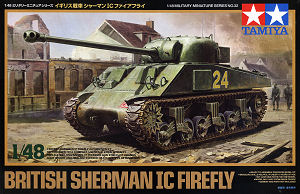
British Sherman IC Firefly
1:48 Scale - Kit No.32532
First Look Review by Terry Ashley
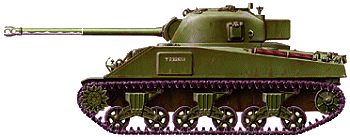



This kit is basically the same as the earlier M4 Early production (kit #32505) with the inclusion of a new sprue “G” with the Firefly turret parts and additional hull parts that include the “sharp” single piece cast transmission cover typical of the IC plus the full array of appliqué armour also typical of the IC with these features being the easiest way of picking the IC from its brothers.
The kit features the later driver’s hoods with periscopes on top and while many of the M4s shipped to Britain for conversion to the IC had the earlier direct vision ports plated over with appliqué armour there is photo evidence of the later hoods as depicted in the kit. Page 62 of Mark Haywards excellent “Firefly” book shows such a configuration as do the 1:35 plans of the IC in the same book.
The kit consist of 137 parts in olive drab plastic plus the lower hull in cast metal and some poly caps for the drive sprockets and gun elevation and of course the decal and instruction sheets.
The standard of the plastic parts is typical Tamiya with cleanly moulded parts with only a few shallow pin marks on the inside of the hatches and track links and all the parts scaled out precisely when compared to the 1:48 plans in the Hunnicutt Sherman bible, especially the barrel which has been a issue with some Firefly kits but this matches the Hunnicutt plans and scaled down 1:35 plans in the Hayward book well within accepted tolerances both in length and muzzle brake size and shape.
The lower hull/Suspension:
This is in cast metal which is now standard for this series and while providing
a robust base for the model is a little lacking in details, for example there
are no bolts on the hull suspension or idler wheel mounting plates and the
underside has a couple of large ‘pits’ for the screws that hold
the hull top in place but there are two plastic squares that fit over the ‘pits’ to
fill these in after assembly.
Added to this is the front transmission cover the top bolted retaining strip but the transmission cover doesn’t have any cast texture which would be very minor in this scale and the fit to the metal tub designed for the earlier three piece transmission cover is not the best. The outer final drive covers help to cover some of the sins but there are a couple of large gaps requiring attention on the lower sides of the cover.
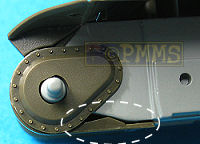
At the rear is the plastic rear hull panel minus the US style towing pintle and with separate engine bay doors for good definition as well as idler mountings, two square air cleaners with the fit to the metal quite good.
The suspension bogies are the same straight arm with raised roller support
with just three parts each plus the two open spoke road wheels per bogie but
build into quite nice assemblies in this smaller scale. There are of course
additional details you can add such as the three bolts on the bottom of each
bogie unit, the small retaining bolts for the track skids and grease plugs
on the wheels if you really want to go that far.
You should note that the top section with the volute springs, track skid and
return roller are mounded as one piece and you just reverse the direction for
the left and right bogies and also the first bogie has a locating pin on the
return roller for location of the track lengths and also has only one locating
pin on the hull so you can’t really put it in the wrong place but take
care when assembling these.
The two revised fancy smooth drive sprockets have poly caps trapped between the two halves and easily fit the front axles while the solid spoke idler wheel has an open back and is glued to the idler axles and you could add the missing bolt heads on the bogie and idler mounting plates if you wish.
The Tracks:
These are again the same T48 rubber chevron tracks in link and length plastic
and have very good details for this scale and don’t appear out of scale
which can be a problem in smaller scales. There is a long length for the
upper and lower track runs with shorter sections for between the drive sprocket/idler
wheels and the lower run with separate links for around the drive sprocket
and idlers wheels.
Fitting the track was straightforward with the upper run attaching to the pin
on the front return roller to ensure they line up correctly but you may want
to leave this till after painting but note the links should be glued to the
return rollers, idler wheels and a couple of road wheels to ensure they stay
in place. The small pin marks on the inside of the tracks are hardly noticeable
once the tracks are in place.
The Upper Hull:
The upper hull is in one piece with separate crew hatches and rear plate but
perpetuates Tamiya’s infatuation with indented weld seams on their
Shermans with all seams on the top hull and glacis represented in this fashion
but it does give you a locating groove to add your own weld beads from thin
sprue or however method you like to add these.
Another Tamiya trait is the open sponson undersides which again give this model the see through look at the sides and rear hull overhang but again should be fairly easy to fill in with strips of plastic card.
A new rear hull plate is provided without the moulded on tools as these were not carried here on the British Shermans.
The details on the hull are quite okay with separate head and tail lights although the bush guards are way too thick and would be best replaced with one of the many etched sets now available for the 1:48 Sherman from ABER, Hauler or Voyager while the front and back lifting eyes are well within scale.
The tools are the same as before with all but two moulded in place with just
the shovel and rear crank handle as separate parts.
Additional parts include the add on armour for the driver’s hoods and
hull machine gun plug plus the appliqué armour for the hull sides while
the crew hatches have basic detail on the insides and again you can add additional
detail such as the hatch springs and periscopes if you wish.
There are fine marks on the hull sides to indicate the location of the appliqué armour so there shouldn’t be any problems fitting but watch the front panel on the right side as it is located about 1mm too far back. The front top corner should sit across the front hull weld seam so just move it forward until in the correct position and these panels could also have the welds roughed up a little for a better appearance.
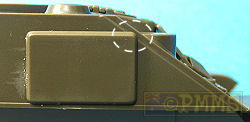
The appliqué armour on the front of the driver’s hoods actually appears slightly too thin and also lacks the rough welds usually seen on these plates and adding these will improve the appearance. There is also a large metal strip bracket missing which is usually fitted to the glacis centreline but this will probably be included in the inevitable etched sets for this kit or you could make it from scrap brass.
The barrel travel lock located on the left rear of the hull has a plastic jig supplied so you can line this up at the correct angle which is an interesting approach instead of adding a couple of locating holes in the hull. But take care here as the jig is designed to be used before attaching the rear hull plate (part G13), if used after the travel lock will be too far back.
The Turret:
This is where most of the changes take place for the Firefly with the upper
shell and lower ring separate in the usual manner with separate gun and rotor
shield, pistol port, lifting eyes and Commander’s split hatchs as well
as the distinctive square Loader’s hatch. The turret shell has the
armoured radio box at the back that features three circular plates on the
top which while not the most common type is certainly evident in photos,
the lower turret ring includes the bottom of the radio box with the fit being
excellent between the turret parts.
The distinctive Firefly gun shield has very subtle cast texture and includes
the .30cal co-ax MG as part of the shield and you should drill this out for
better appearance while the gun tube is in one piece with one half of the muzzle
brake separate leaving only the minor moulding seam and small join line on
the muzzle brake to take care of.
The internal gun mounting is attached with two poly caps which allow gun elevation
after assembly and also allows you to add the rotor shield and gun at any time.

Other Firefly turret features include the 2” bomb thrower on the left side, additional British aerial mount at the rear and the inclusion of the vane sight next to the front periscope although this has a small square around it where the turret mould has been altered and you may want to smooth this out. The two vane sights are also a little on the thick side and you can thin these or use the etched items from any of the available etched sets. The right cheek appliqué armour is provided but no .50cal MG is included but most wartime photos show this was not carried in any case.
The hatches have pin marks on the inside that will require careful removal if shown open and the periscope mounting inside the Commander’s hatch is a little bare but again the available etched sets will deal with this.
The Decals:
The decal sheet is typical Tamiya with well printed markings but thickish carrier
film and has markings for three Fireflys;
Decal sheet
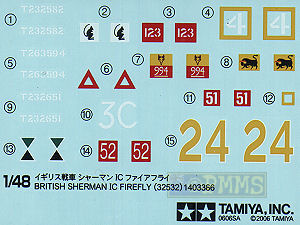
The Sprues
Click on thumbnail for larger view



Detail images


Close new window to return to review
The turret assembled without problems with excellent fit of parts apart from minor trimming of the Commander’s hatches to allow them to sit inside the hatch ring if shown closed but other than that everything fell together.
Conclusion:
Overall another nice little model in this scale but the metal hull is still
lacking in detail and the open sponsons distract a little from the final appearance
but can be fixed easily. The Firefly details are quite well done overall despite
the less common features such as the driver’s visors, circular panels
on the radio box or the IC itself. There is plenty of scope for adding additional
details and the base model can be put together quite quickly or you can spend
the extra time whichever you prefer.
This model should be welcomed by British armour modellers with the important barrel dimensions and Firefly features being very good to give that distinctive look to the Firefly.
Highly Recommended.
Update sets:
There are already many update sets available that will be applicable to this
kit but specific sets will no doubt be available shortly.
See the Sherman subject page for updates sets reviewed.
| Sherman Firefly Mark Hayward Barbarossa Books ISBN 0-9538777-2-8 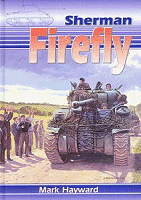 |
||
| SHERMAN A History
of the American Medium Tank R.P.Hunnicutt. Presidio Books ISBN 0-89141-080-5 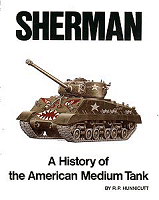 |
Modeler's Guide
to the Sherman MMIR Special. Ampersand Publishing Company, Inc 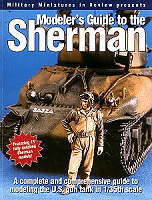 |
Page created June 28, 2006